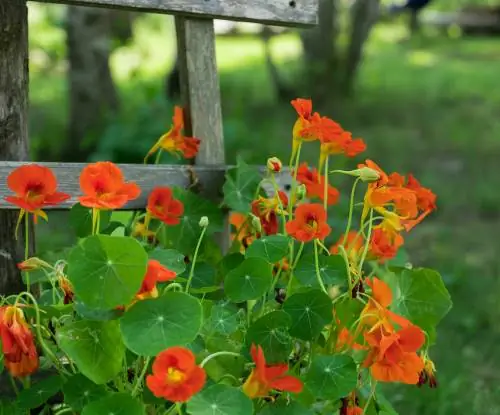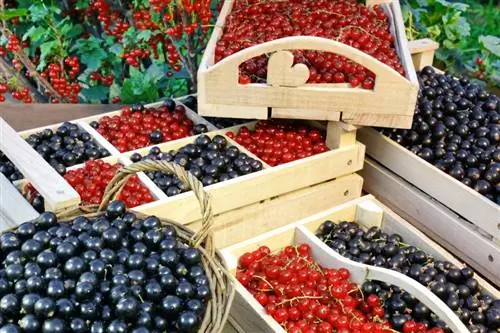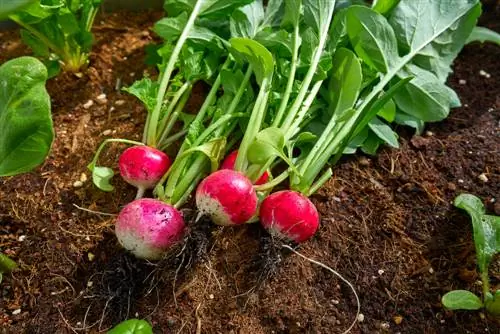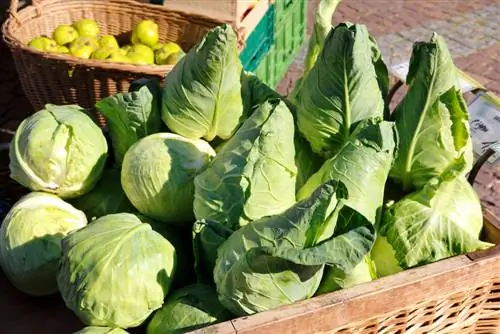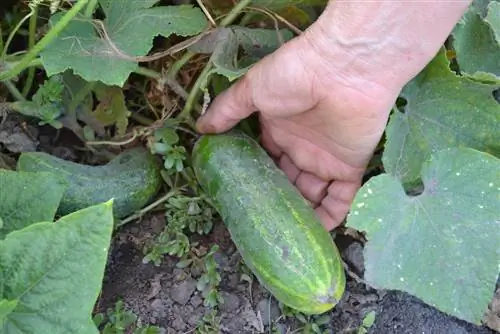- Author admin [email protected].
- Public 2023-12-25 17:45.
- Last modified 2025-06-01 06:02.
When people talk about “nasturtiums”, most people mean the edible large nasturtium (bot. Tropaeolum majus), although there are a few other very interesting species for balconies and gardens. However, the easy-to-cultivate Tropaeolum majus is the most widespread variety of the genus in gardens and on balconies, which is why this article provides you with detailed instructions for planting and care - and of course at the end you will find a list of the most beautiful species and varieties.
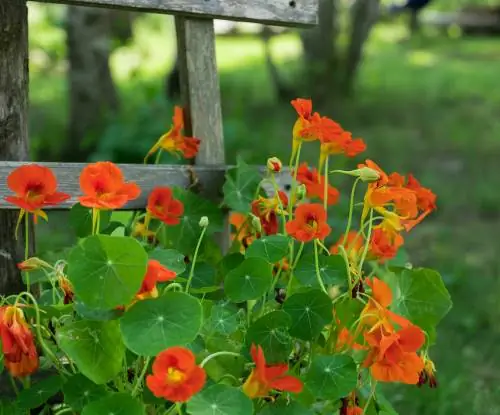
What is nasturtium and how to care for it?
The nasturtium (Tropaeolum majus) is an edible, annual climbing plant that is well suited for greening pergolas and fences. It requires a sunny location and moderately humus-rich soil. Its leaves and flowers are edible raw and are suitable as a seasoning for salads, sauces or herb butter.
Origin and distribution
The large nasturtium (bot. Tropaeolum majus) comes from Central and South America, where it grows wild primarily in Brazil and Peru, but also in Chile and Bolivia. It is probably the best-known representative of the nasturtium plant family (bot. Tropaeolaceae), which includes around 90 species, although the garden form used in this country is a hybrid. The wild form is considered a medicinal plant in its homeland because of its antibacterial ingredients, which is why it was named “Medicinal Plant of the Year” in 2013.
Usage
The nasturtium is a climbing plant that, thanks to its long and densely leafy tendrils, is ideal as a privacy screen and for greening pergolas and garden fences. The plant grows reliably and quickly up any climbing aid - both in height and width. Plant the species directly in the bed or in a flower box or pot; the different colored varieties can be used to create pretty arrangements on the balcony or in the flower bed. Planting in a raised bed on the terrace in which you have installed a trellis looks particularly pretty - this gives your favorite place in the garden a green privacy wall. Planted without a trellis, the large nasturtium also looks good in hanging baskets - with hanging shoots - or as a ground cover. But be careful: the plants take every opportunity to climb!
You can also plant the medicinal and culinary plants in the vegetable patch to ward off pests and diseases, especially in plantations with longer-growing crops such as broccoli, cauliflower, kohlrabi, celery, radish, beans, peas, cucumbers, etc Fennel. Planting on apple and peach trees as well as in rose beds also counteracts lice infestation.
Use as a culinary herb and medicinal plant
The natives of South America have been using nasturtium as a remedy for many centuries. The infusion is said to help especially with colds, bronchitis and urinary tract infections, but excessive consumption quickly irritates the gastrointestinal area due to the pungent substances it contains. For this reason, you should only use the hot and spicy-tasting leaves and flowers of the plant sparingly in the kitchen, for example in salads, sauces or herb butter. Nasturtiums also taste great as a topping for bread. However, you can soak flower buds that are still closed and unripe fruits in herbal vinegar and use them as a tasty caper substitute. Furthermore, a decoction of fresh leaves and flowers can be used for hair care, for example as a conditioner for scented hair.
Appearance and growth
In its South American homeland, the nasturtium grows as a perennial. In our case, however, the plant does not survive the cold and wet winters, which is why it dies with the arrival of the first frost. However, their seeds usually survive the cold season without any problems, so that new plants will germinate in the same place next spring. The large nasturtium grows creeping and forms long tendrils that can reach lengths of three to five meters. The species is therefore very suitable as a ground cover, but strives for heights at every opportunity. The plant forms round, thin stems on which the leaves and flowers stand upright at a height of around 20 centimeters.
leaves
The large, shield-shaped leaves of the large nasturtium have a smooth edge and are colored light to dark green, depending on the variety. The nine clearly visible leaf veins that radiate from the center are also characteristic. Also typical of the species is the so-called lotus effect, in which water that hits the leaves simply rolls off. The hot and spicy-tasting leaves can be used fresh and raw as a herb and taste finely chopped in herb butter, quark or salad, for example. Young and light leaves have a significantly milder taste than older and darker leaves.
Flowers and flowering time
The nasturtium owes its name to the nasturtium monks, whose robes with pointed hoods vaguely resemble the large, showy flowers with the pronounced spur. The calyxes are usually bright red, orange or yellow and can also be plain or patterned. They appear between July and October and appear decorative as single flowers on the long tendrils. The flowers also have a pungent aroma reminiscent of the taste of mustard, but are somewhat milder than the leaves. They are very suitable for decorating salads or desserts, but be careful: earworms like to hide inside that you certainly don't want to eat. After picking, shake the flowers carefully to prevent the animals from falling out. Pollination is carried out by insects, which find nasturtiums very attractive as a food plant.
Fruits
After flowering, the large nasturtium produces single-seeded split fruits that are quite large and, when unripe, are also edible as false capers. When fully ripe, you can dry and grind them - they produce a slightly spicy seasoning powder for soups, sauces and stews. Be careful when cultivating it outdoors in the garden: Nasturtiums - although the plant itself is not hardy - like to sow itself, so you may be surprised with numerous seedlings next spring.
Toxicity
The large nasturtium is not poisonous, but can even be used as a seasoning and medicinal herb. However, this does not apply to all species of the genus, which in turn may not necessarily be poisonous, but are still not edible. Traditionally, only Tropaeolum majus and Tropaeolum tuberosum are used as food plants.
Which location is suitable?
The nasturtium is one of the sun-loving summer bloomers and thrives best in a protected, sunny location in the bed or on the balcony. The light exposure has a direct influence on the luminosity of its flower colors as well as on the number of flowers: the sunnier it is, the more flowers it produces - and these have stronger colors, while specimens cultivated in partial shade and shade mainly have leaves and only a few, develop pale flowers.read more
Soil / Substrate
The nasturtium also develops many leaves but only a few flowers in nutrient-rich soil. Therefore, place them in soil that is only moderately rich in humus, if possible with a higher proportion of clay and/or sand. This should be well-drained, as the plant - like so many - does not tolerate waterlogging. As a substrate for a pot culture, use humus-based potting or potting soil, which you can thin down with a little sand.
Sowing/advancing
The nasturtium, which is only one year old, usually sows itself in the flower bed. You can also grow the plants on the windowsill between February and April, which works best as follows:
- Soak seeds in warm water for a few hours
- Fill cultivation pots with nutrient-poor substrate
- insert pea-sized seeds two to three centimeters deep
- cover with soil - dark germinator
- care in a bright but not directly sunny place at room temperature
- Keep substrate evenly moist
- tense air (covering with foil or similar) promotes germination
- Germination occurs after two to three weeks
- Planting out into the bed possible from the end of May after the last late frosts
Pre-grown nasturtiums bloom faster, but you can also sow the seeds directly into the bed or planter from May onwards. The plants grow very quickly, so growing them is not absolutely necessary. Sowing is possible until the end of June.
Watering nasturtiums
The water requirement of the nasturtium depends very specifically on its location: the sunnier and warmer the plant is, the more water it needs - especially since the species evaporates a lot of moisture due to the large leaf mass and therefore has a fairly high water requirement from the start. You should therefore water potted plants daily in the summer months, provided it is dry and not raining. If there is a lack of water, the plant immediately drops its leaves. Also, always water from below and never over the flowers, as they will then fall off.
Fertilize nasturtiums properly
Fertilization should also be avoided for potted plants, as an excess of nutrients only stimulates leaf growth - at the expense of the abundance of flowers.read more
Cut nasturtiums correctly
You can cut off tendrils that are too long and dead shoots with sharp, clean scissors. In particular, removing the flowers extends the flowering period so that you can enjoy the bright colors well into autumn. To obtain seeds, simply leave a few flowers on the plant and harvest the ripe fruits in autumn.
Propagate nasturtiums
In early autumn you can take cuttings that root very quickly. However, you have to overwinter them and not plant them out until the following spring.read more
Wintering
Although frost-free but cool overwintering (e.g. in an unheated winter garden) of the non-hardy nasturtium is generally possible, it makes little sense due to the uncomplicated cultivation of the plant. Care during the winter months is more time-consuming than annual re-sowing, especially since pests and diseases tend to nest during overwintering.read more
Diseases and pests
With its mustard oils, the large nasturtium defends itself very successfully against many fungi and pests, which is why you can plant it in the flower and vegetable bed as a preventive measure. Nevertheless, the plant is popular with aphids (and they keep the creatures away from roses) as well as the cabbage white butterfly, which likes to lay its eggs on the leaves. A caterpillar infestation is shown by the typical feeding marks.
Tip
Yellow leaves, if they only appear sporadically, are normal and can simply be plucked off. However, if the discoloration is more pronounced, this is often an indication of too much or too little water.
Species and varieties
There are around 90 different species of the nasturtium genus, although only five species are cultivated as ornamental plants. The various varieties of small nasturtium (bot. Tropaeolum minor) are particularly suitable for growing in balcony boxes and pots, as they only grow to around 30 centimeters high and have a rather bushy growth. Tropaeolum majus, the large nasturtium, is the well-known edible species. However, it develops tendrils up to three meters long and should therefore be given a place in the garden. We will introduce you to other species and their varieties in more detail here.
Large nasturtium (bot. Tropaeolum majus)
The fast-growing species is native to the forests of Brazil and Peru, but has also been cultivated here for a long time. The large nasturtium grows bushy or creeping, depending on how it is grown. Without a climbing aid, the plant only grows to a height of around 50 centimeters, but with a climbing option - such as a wall or a fence - it can reach a height of up to three meters in good growing conditions. The different varieties usually bloom yellow, orange or red. But there are also two- or multi-colored varieties, although the flower color usually depends on the weather: in cool temperatures and little sun, the colors remain pale. They only gain their luminosity in warm summer temperatures and lots of sunlight. Both the leaves and the flowers of the species are edible, and you can also pickle the buds and the unripe fruits as false capers. The species is an annual and dies at the end of summer, but its seeds overwinter and germinate on their own the next spring.
Popular varieties include:
- ‘Alaska Mix’: multicolored flowers, white variegated leaves
- ‘Colorful Jewels’: multicolored mix with ruffled flowers
- 'Cherry Rose': cherry red flowers
- 'Cream Troika': light yellow flowers with dark spots
- ‘Jewel of Africa’: Mixture of different colored flowers
- ‘Salmon’: salmon-colored flowers
- ‘Milkmaid’: light yellow flowers
- ‘Moonlight’: light yellow flowers
- 'Night and Day': flowers in two colors white and dark red
- ‘Orange Troika’: bright orange flowers
- ‘Orchid Flame’: yellow-red patterned flowers reminiscent of orchids
- 'Scarlet Gloss': semi-double, bright red flowers
- 'Variegated Queen': mixed colors with speckled foliage
The subspecies Tropaeolum majus 'Nanum' remains low with a height of around 30 centimeters and does not climb. It is very suitable for pots and other planters on the balcony or terrace.
Small nasturtium (bot. Tropaeolum minor)
The small nasturtium, native to Peru and Ecuador, grows rather bushy and is between 30 and 59 centimeters high. Their shoots don't grow. The flowers, which mostly bloom in shades of yellow and red, appear between June and September and decorate sunny to bright, partially shaded locations on the balcony or terrace. Plants don't grow in the shade.
Popular varieties include:
- ‘Black Velvet’: dark purple flowers with yellow center
- 'Garden Jewel': different colored mixture with bright colors
- 'Empress Victoria': velvety red flowers
- ‘Oriental magic’: deep velvet red flowers
- ‘Peach Melba’: peach-colored flowers with a darker center
- 'Sangria': beautiful, strong red flowers
- ‘Sun Carpet’: bright yellow flowers
- 'Tip Top Scarlet': numerous fiery red flowers
- 'Vesuvius': salmon-colored flowers
- 'Whirlybird': different colored mix of red and yellow, semi-double flowers
Canary nasturtium (bot. Tropaeolum peregrinum)
This species, also known as the “canary nasturtium”, comes from Central America and has its name for a reason: the yellow flowers are characterized by strikingly large petals with slits on the edges and therefore look like bird wings. The species, which is perennial in its homeland, is not hardy and is therefore only cultivated here as an annual. The climbing tendrils grow up to two meters high and require a trellis or other climbing aid. The fast-growing climbing plant is suitable for greening pergolas and wire mesh, but can also be grown in hanging baskets, hanging baskets or in pots. A popular variety is the 'Goldvine' with its bright golden yellow flowers.
Bulb nasturtium (bot. Tropaeolum tuberosum)
The species, also known as “Mashua”, grows primarily in Peru and Bolivia and serves as a food source for the local population, as the tubers of the plant are edible - cooked or roasted. In our country, the bulbous nasturtium is rarely grown, but it can be cultivated in a similar way to dahlias: Dig up the bulbs before the first frost and store them in a dark, cool place to replant them next spring. The species is a climbing plant whose fast-growing tendrils reach up to four meters high and require climbing aid.
Tricolor nasturtium (bot. Tropaeolum tricolor)
Tropaeolum tricolor, the tricolor nasturtium or Chilean nasturtium, is a perennial plant species from the Tropaeolaceae family. The species is endemic to Chile, where it grows in the cloud forest of the coastal mountains of northern Chile at 300 to 900 meters altitude and further south in the inland temperate forests. The tubers are hardy down to around minus eight degrees Celsius and can also tolerate a blanket of snow for a short period of time. The most striking feature of the climbing plant is its numerous - as the name suggests - tricolor flowers in red, yellow and blue.

